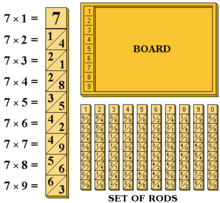Rulers
Calculating sticks and calculating plates are a calculation aid . They were used in preschool and elementary school as an introduction to set theory . The Napier'schen rods (also in German-speaking Nepper'sche computing sticks called) found up until the 1920 year as a means for multiplication and division using.
Set theory (sticks and plates)
The sticks were elongated, about 6 cm long sticks made of wood or plastic, which were colored in different shades. The plates that were used in primary schools in Germany in the 1970s were in four colors (red, yellow, blue, green), in three shapes (round, square, triangular), in two sizes (large, small) and with two types of surfaces (rough, smooth). These 48 tiles in total were used, among other things, to represent group associations, such as subset and intersection . They were part of the basic equipment in mathematics lessons in first graders and were given out to the students as part of the freedom of learning materials .
Napier ruler
The Scottish mathematician Lord John Napier of Merchiston (1550-1617) invented the first multiplication aid. These sticks or narrow strips, which contain the multiples of one to nine times each of the numbers 1–9 in such a way that the ones stand diagonally to the right below the tens.
By means of such sticks one can easily form the multiples of any number. These sticks are used to facilitate multiplication and division in so far as the computer can write down the multiples of the multiplicand at the same time. John Napier of Merchiston described these sticks in the text Rhabdologiae seu numerationis per virgulas libri duo (Edinburgh 1617).
